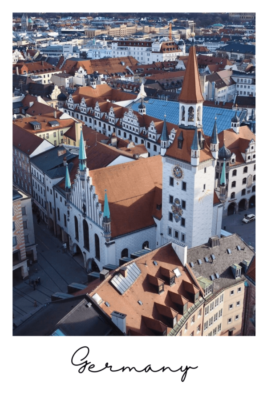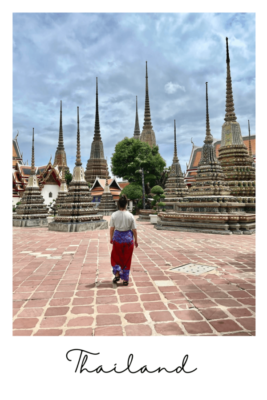The perfect self guided walking tour of Munich you need
Come along with me on the ideal self guided walking tour of Munich.
Searching for the best way to see the Bavarian capital that will show you around the oodles of cathedrals, quirky sights and hidden gems?
I’ve got the goss on miracle princes, dragons climbing town halls, even a devil’s footprint and I can’t wait to give you the inside scoop.
There’s even a stop at the most famous beer hall in Munich! Ready to go explore?
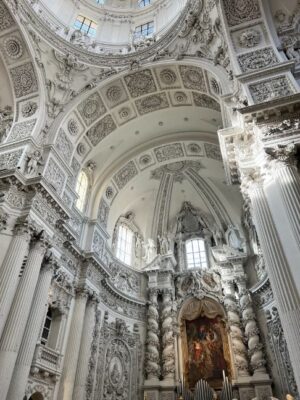
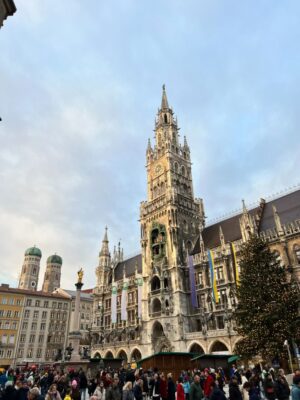

Map of this self guided walking tour of Munich
I’ve compiled a list for you of all the main sights that we cover on this jampacked self guided walking tour of Munich.
If you’re just keen to grab the map and the list of spots, copy this part down. Read on further for the full rundown on each spot.
1. Stachus
2. Bürgersaalkirche
3. Richard-Strauss-Brunnen
4. St. Michael München
5. Frauenkirche
6. Mariensäule
7. Neues Rathaus + Glockenspiel
8. Wurmeck
9. Altes Rathaus + Talburgtor
10. Alter Peter + tower climb
11. Rindermarkt + Ruffinihaus
12. Asamkirche
13. Sendlingertor
14. Münchner Stadtmuseum
15. Viktualienmarkt
16. Hofbräuhaus
17. Pfistermühle
18. Alter Hof
19. Munich Residenz
20. Feldherrnhalle
21. Theatinerkirche
Bonus sights
22. Hofgarten
23. Englischer Garten
24. Chinesischer Turm
25. Eisbachwelle
Looking for the perfect Munich 3 day itinerary instead? All these sights plus food recommendations!
Stachus, Bürgersaalkirche + Richard-Strauss-Brunnen
First up, we’re exploring our way from the train station in towards the Altstadt or Old Town, still ringed by its former defences.
Take Bayerstraβe and wander towards Stachus or Karlsplatz, one of the busiest sections of Munich.
Actually named for a pretty unpopular prince who tried to trade Bavaria for a chunk of Austria, the locals refer to the square instead as Stachus after a pub that used to stand here.
You’ll see the same name on official signs and even subway and tram stops.
The little gate standing in the middle is called Karlstor and dates from the 14th century. The buildings on either side are much more recent, from 1900.
This gate is the start of Munich’s pedestrian zone, safer photo ops for all!
As you wander along the vast Neuhauser Straße, we’ve got some Baroque delights ahead of us, prepare for gold accented everything.
Your first stop is on your left, you’ll notice the delightful rose-pink façade amongst the grand townhouses.
Originally a large hall for the general public, Bürgersaalkirche was converted to a church in 1778.
Upon first entering the austere lower hall, the interior seems modest, but all of this is blown away when you ascend the stairs to the opulence above.
Admire the roof, richly adorned with frescoes and religious art scattered throughout.
Head on further, you’ll find the Richard-Strauss-Brunnen, named for the famous composer who was born just one street over.
The decorated reliefs display figures from his works, most notably the opera Salome.
Unfortunately, this was also closed for refurbishment when I stopped by, but I believe it’s now open again for your viewing pleasure.
St. Michael München + Frauenkirche
Continue along the street down towards the city center, the next stop is the immense St. Michael München.
You’ll know when you’re in the right spot by the many white statues ensconced in their maroon niches and statue of the Archangel Michael going to town on a devil at street level.
Stepping inside the enormous barrel-vaulted church, it’s only outdone for size by St Peter’s Basilica in Rome.
Masterful paintings and ornate details pepper the inside of this Wittelsbach showstopper, they’re buried in the crypt downstairs, accessible for a 3€ entrance fee.
Including the resting place of “mad” King Ludwig II, responsible for building Neuschwanstein Castle and almost bankrupting the kingdom of Bavaria before mysteriously drowning in a lake.
Now onto one of Munich’s most beloved sights, you can probably spy the twin onion topped domes from afar, the jumbo sized Frauenkirche.
Frauenplatz is just a bit further on from St Michael’s to the left and you’ll know the red brick cathedral instantly from all the postcards you’ve passed on your way in.
Built as an affirmation of the Catholic majority in Bavaria vs the rest of Germany, the construction nearly ran out of money a few times and was saved by the Pope personally intervening, or according to some legends, a deal with the devil.
On your way around the enormous columns, you might spy a bronze footprint, said to be that of the devil’s stomp once he realised he had been cheated out of his design ideas for a church with no windows.
Sustaining heavy damage in WWII, only the two towers stayed standing throughout the conflict and remain a much-loved symbol of the city.
Luckily for us the cathedral was reconstructed to its former glory. Don’t miss the enormous stained-glass windows as you move through the pews, invisible as you initially enter.
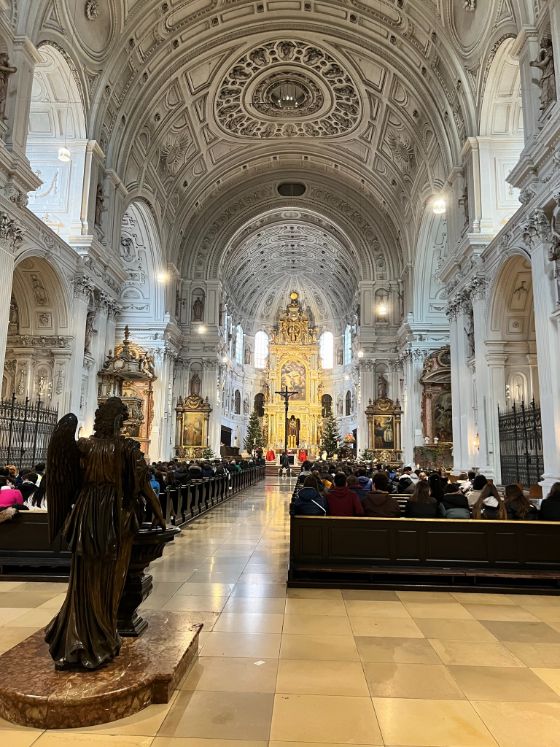
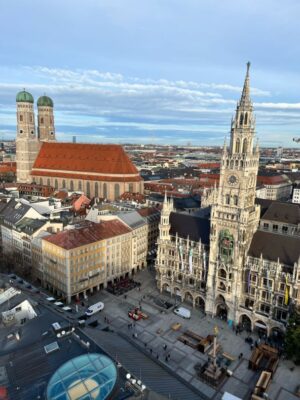

The beating heart of Munich: welcome to Marienplatz

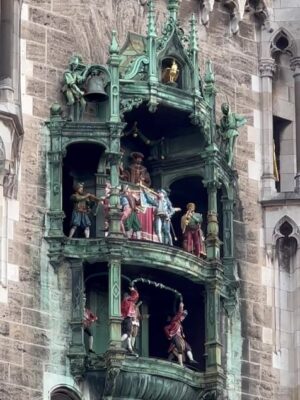
The next stop is the Marienplatz, essentially the beating heart of Munich’s Altstadt or Old Town, named for the golden statue of Mary atop her sky-high column and fountain in the middle of the square.
The Mariensäule (Marian column) was the first of its kind north of the Alps, built in thanks after years of plague and war.
This has been the centre of Munich since its very beginning and it’s still a gathering place for locals and tourists alike, overlooked by the fairytale Neues Rathaus or New Town Hall.
I love the dramatic spires that seem to top every notch and the large Glockenspiel clock, complete with life-size dancing statues who spring into life 2-3 times a day and act out a little performance to music.
Stop here at 11am or 12pm to watch the melodic show made up of 32 characters and 43 bells, keeping in mind that this was state of the art stuff in 1908 when it was created, it’s no Hollywood blockbuster but charming regardless.
If you want to be even closer to the action, head over to the Hugendhubel bookstore opposite and go up to the 3rd floor for an eye level view!
Note: Munich is generally a very safe city, but it’s a good idea to have your bag zipped up and in front of you while you’re occupied with which knight wins the jousting contest high on the façade of the town hall.
As you’re admiring the building itself, don’t miss the dragon climbing up the western corner – the Wurmeck. Said to have been the cause of an outbreak of bubonic plague and dispatched by a quick-thinking soldier and his trusty cannon.
You can even enjoy a meal here in the historic Ratskeller beneath the town hall, complete with murals of merry monks imbibing home brewed beer, you can check their opening times on the official website.
Down the other end of Marienplatz, you will find the copper-spired Altes Rathaus or Old Town Hall, a little reminder of Munich’s medieval history which has been superseded over the centuries.
The tower attached to it is called the Talburgtor (Valley Fort Tower) and it used to be part of the original fortifications surrounding the market town of Munich, back when it was still being run by monks.
Destroyed in WWII, it’s been restored faithfully to look similar to the original buildings and the tower now houses a toy museum.
Alter Peter: the grand old gentleman of Munich
Head around the corner to the ancient Peterskirche, also known as Alter Peter or Old Peter, predating Munich itself as a city.
Stepping inside, you’ll be surrounded by Baroque splendour and oddly enough, there’s even a jewel encrusted saint’s skeleton waiting for you inside.
St Munditia was martyred around 310 AD and her bones have lain in this gilded casket for centuries, she’s known as the patron saint for spinsters or unmarried women.
Once you’ve had enough of the saints and relics inside the church, head back out to the ticket office for the climb up the bell tower of Alter Peter and the most incredible view over the rooftops of Munich.
If you’re game for 308 steps and something of a caged viewing platform at the top, this is the ultimate view over the fairytale Neues Rathaus, the Frauenkirche and even to the Alps on a clear enough day.
Tickets cost 5€ for adults and 2€ for children, if you’d like the view to yourself, it’s best to be here first thing in the morning when it opens at 9am.
This was my favourite experience in Munich, standing high above the majestic rooftops of Munich soaking up the incredible views!
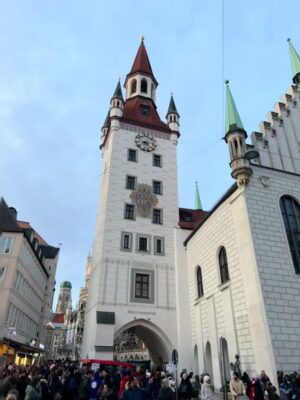
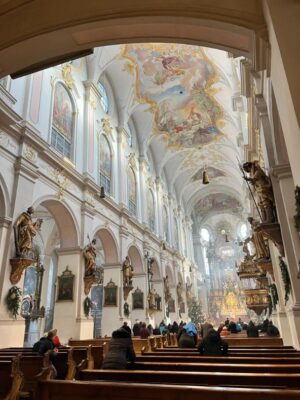

Onto the prettiest chapel you ever did see
Turning down Rindermarkt, you’ll pass through what used to be the cattle markets of the city and you’ll be able to spot a few beefy statues standing around the cascading fountain.
Don’t miss the Ruffinihaus covered in elegant murals just across the square, 3 grand townhouses all joined around a central courtyard and housing a few different shops.
Wind your way to Sendlingerstraβe and my all-time favourite church, step into the utterly decadent Asamkirche.
Built by two brothers (who became famous throughout Europe for this decadent church) to the most opulent, insanely Rococo chapel.
Although tiny in size with only 12 pews, every square inch of the interior drips with sculptures, stucco gilding and paintings.
It really has to be seen to be believed, outside it’s a strange building within a shopping strip and inside a gold and marble fever dream.
Don’t forget to look up and admire the roof and upper balconies, elaborately decorated in the same OTT style as the lower floor.
I wonder how much time the brothers spent watching the goings on in their masterful church from the house next door, apparently, they constructed it so the altar would be visible from their bedrooms.

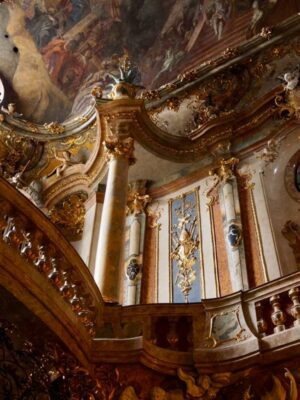

Down the far end of the street, you’ll find Sendlinger Tor, one of the former medieval gates into the city, stunning in the warmer months when it’s covered in charming vines.
The jumbo brick towers date to the 14th century and once overlooked a moat surrounding Munich, complete with a drawbridge.
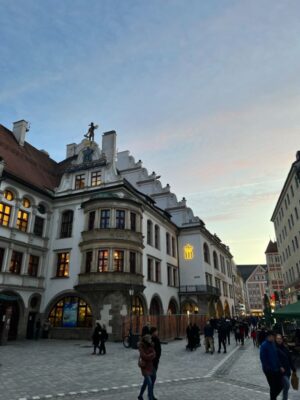
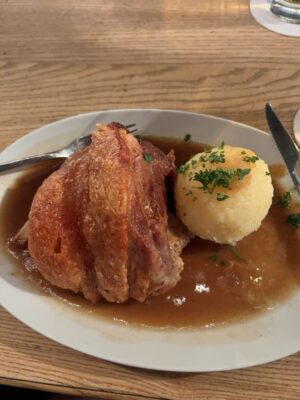
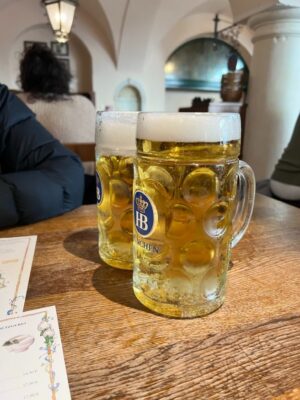
A museum, a market and the world famous Hofbräuhaus
Strolling back towards the city, jump over onto Oberanger street and you’ll pass by the Münchner Stadtmuseum, home to exhibitions covering all of Munich’s history from a tiny monastery through to modern metropolis.
It’s housed in a former armoury, I found the little spires quite charming.
Entry is 7€ per adult and audioguides are free, most signage is in German only.
Continuing on back past the museum down Rosental street will bring you to one of the city’s most loved spots, the sprawling Viktualienmarkt.
Stalls sell fresh produce, as well as cooked food, with a beer garden to boot.
As you work out what to order, don’t miss the decorated Maypole in traditional Bavarian colours of blue and white.
If the weather isn’t so conducive to sitting outside when you visit, there are plenty of restaurants ringing the market with indoor seating.
Alternatively, if you’d prefer to wait for the ultimate beer hall experience, next we’re heading to the state-owned Hofbräuhaus, perhaps the most famous beer hall in Munich.
Cheerfully rowdy inside, complete with live oompah music and wait staff all kitted out in traditional dirndls and lederhosen, this is the closest you’ll get to Oktoberfest outside of the festival itself.
There are even giant pretzels for sale roaming through the dining hall.
The building dates from 1607 and was started up to brew beer for the kingdom of Bavaria as they were importing it at great expense, eventually the brewery was bringing in over 30% of the kingdom’s income just through beer sales!
The food here doesn’t necessarily break any culinary boundaries, but it is tasty and traditional. As good a spot as any to try a Schweinshaxe or pork knuckle, traditional Oktoberfest fuel.
Searching for the perfect guide to the real Oktoberfest? I’ve even included a map!
Note: You’ll need to find a seat to be served here but many of the tables are communal so don’t be afraid to ask if you can pop on the end (within reason of course).
The wait staff will keep your bill separate from the others at the table. If a table has a sign saying Stammtisch, it means that it’s reserved.
The Royal Mill and two Royal Palaces
Pass the charming Pfistermühle restaurant on your way over to the next attraction.
Covered in vines, before this was a restaurant, it was a mill for the royal bakers, complete with a waterwheel and large storage for the flour produced.
A far cry from the upscale eatery that we see today, no medieval moat in sight!
Next up, the Alter Hof, former royal residence from the 1100s, before the family moved over to grander palaces.
The large central courtyard used to be full of artisans and farm animals, hard to imagine it covered in gardens and pigs today.
From 1385, the family moved to a castle with better protection from the not so supportive townspeople of Munich just north of here, now the Munich Residenz and our next stop.
The Residenz, as it currently stands, is the largest palace within German city boundaries and has been an illustrious home for generations of ruling Wittelsbach’s.
Lavishly decorated interiors, including the stunning Antiquarium Hall and glittering Treasury, display the former wealth of Bavarian royalty back when it was still a kingdom.
Damaged badly in WWII, the palace has now been masterfully restored but you might still be able to appreciate cut marks in the paintings where they were cut out of their frames before bombing raids during the conflict.
Admission is 14€ for a combo tickets to see the palace and treasury buildings, there are more options if you’d like to see inside the lavish Cuvilliés Theater, audioguides are included in the price of admission.
Note: Tickets can only be purchased in person at the ticket office on site, so best to go first thing in the morning if you’d like to skip the crowds, the complex opens at 9am in the warmer months and 10am through the off season.
I like my churches daffodil yellow
Stepping out of the palace, cross now to the Odeonsplatz, home to the Feldherrnhalle with its grand lions guarding marble steps.
On the podium, dramatic statues of Bavarian war heroes stand proud looking over the square, made from melted down war cannons.
Inspired by the Loggia dei Lanzi in Florence, it’s easy to see the similarities in this monument created for the Italophile King Ludwig I.
Across the square, we find the sunflower yellow Theatinerkirche, built in thanks for a long-awaited Wittelsbach heir born in the 17th century and another Italian inspired monument.
Inside, almost every surface is lily white with delicate cherubs, leaves and flowers decorating pillars and walls alike.
The church feels light and airy thanks to the careful use of light and shadow, Max Emanuel, the prince that this church was built for, is buried here along with his devoted parents.
Feel free to pause here and take a seat in one of the pews to admire the stunning architecture, after the Asamkirche, this is my second favourite church in Munich.
Feel free to finish up your walking tour of Munich here, if you’ve still got fresh legs and you’re keen for some greenery, I have two more spots for you to see!
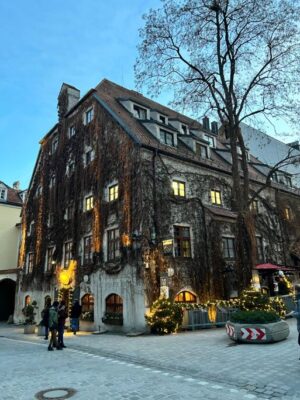
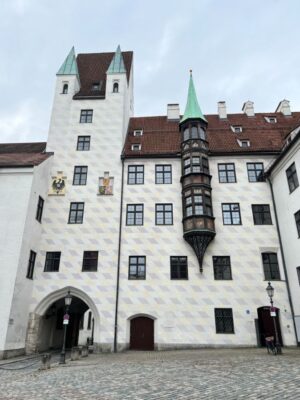
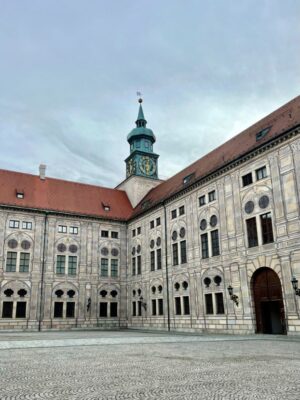
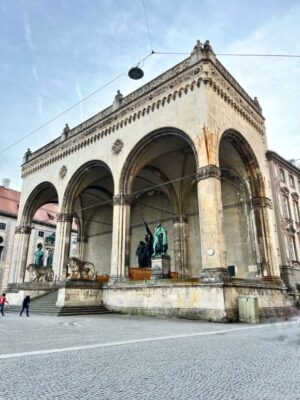

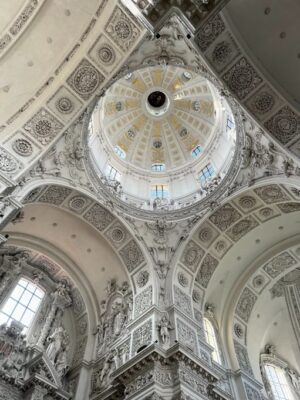
Searching for another jam-packed self guided tour? How about my walking tour of Nuremberg
Englischer Garten: Munich’s playground
Crossing over Odeonsplatz, head for the green space ahead of you, the symmetrical Hofgarten with a round temple dedicated to Diana, the same as it was when dukes and kings were the ones strolling along the elegant pathways.
In the warmer months, you’ll often find live music being played here, feel free to stop and enjoy a while.
Once you’ve enjoyed the classical delights of the Hofgarten, continue through to the gigantic green space of the Englischer Garten.
Larger than Central Park in New York at over 5km in length, the meadows were formerly hunting grounds for the royals at the Residenz.
These days, they host a variety of attractions, including a hilltop temple (the Monopteros), replica Japanese tea house (Japanisches Teehaus), Chinese tower (Chinesischen Turm) and adjoining beer garden, as well as surfers famously testing the icy waters of the Eisbach stream running through the park.
Bonus points if you bring your own picnic with you to enjoy in the sunshine and greenery with the locals, the Biergarten am Chinesischen Turm is open only in fine weather but there’s also a kiosk selling takeaway food when it’s too cold or wet for full service outside.
Pop past the intrepid surfers in their wetsuits taking on the Eisbachwelle on your way back into the city, far braver than myself!
You’ve reached the finish line of this self guided walking tour of Munich
Our ramble through the green fields of the Englischer Garten brings our wonderful walking tour through Munich to an end.
We’ve explored Munich’s medieval defences and strolled through royal residences, as well as eye-poppingly beautiful churches.
And even snuck in a quick hit of Bavarian hospitality at Hofbräuhaus!
I hope that you found this guide to some of Munich’s top attractions useful in illuminating all the incredible things to see in this bustling city and it helps you plan what to see when you’re visiting.
Don’t forget to save this for later on by pinning it below and sharing with your travel buddies.
Looking for another delightful Bavarian destination? Here’s my ultimate guide to Nuremberg


